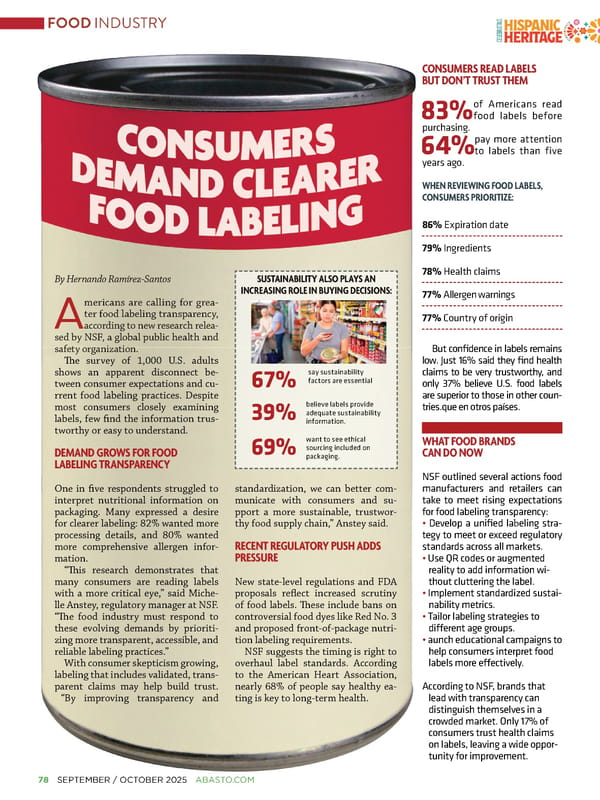78�SEPTEMBER / OCTOBER 2025�ABASTO.COM CONSUMERS READ LABELS BUT DON’T TRUST THEM 83% of Americans read food labels before purchasing. 64% pay more attention to labels than five years ago. WHEN REVIEWING FOOD LABELS, CONSUMERS PRIORITIZE: 86% Expiration date 79% Ingredients 78% Health claims 77% Allergen warnings 77% Country of origin But confidence in labels remains low. Just 16% said they find health claims to be very trustworthy, and only 37% believe U.S. food labels are superior to those in other coun- tries.que en otros países. WHAT FOOD BRANDS CAN DO NOW NSF outlined several actions food manufacturers and retailers can take to meet rising expectations for food labeling transparency: • Develop a unified labeling stra- tegy to meet or exceed regulatory standards across all markets. • Use QR codes or augmented reality to add information wi- thout cluttering the label. • Implement standardized sustai- nability metrics. • Tailor labeling strategies to diferent age groups. • aunch educational campaigns to help consumers interpret food labels more efectively. According to NSF, brands that lead with transparency can distinguish themselves in a crowded market. Only 17% of consumers trust health claims on labels, leaving a wide oppor- tunity for improvement. standardization, we can better com- municate with consumers and su- pport a more sustainable, trustwor- thy food supply chain,” Anstey said. RECENT REGULATORY PUSH ADDS PRESSURE New state-level regulations and FDA proposals refect increased scrutiny of food labels. Tese include bans on controversial food dyes like Red No. 3 and proposed front-of-package nutri- tion labeling requirements. NSF suggests the timing is right to overhaul label standards. According to the American Heart Association, nearly 68% of people say healthy ea- ting is key to long-term health. SUSTAINABILITY ALSO PLAYS AN INCREASING ROLE IN BUYING DECISIONS: 67% 39% 69% say sustainability factors are essential believe labels provide adequate sustainability information. want to see ethical sourcing included on packaging. By Hernando Ramírez-Santos A mericans are calling for grea- ter food labeling transparency, according to new research relea- sed by NSF, a global public health and safety organization. Te survey of 1,000 U.S. adults shows an apparent disconnect be- tween consumer expectations and cu- rrent food labeling practices. Despite most consumers closely examining labels, few fnd the information trus- tworthy or easy to understand. DEMAND GROWS FOR FOOD LABELING TRANSPARENCY One in fve respondents struggled to interpret nutritional information on packaging. Many expressed a desire for clearer labeling: 82% wanted more processing details, and 80% wanted more comprehensive allergen infor- mation. “Tis research demonstrates that many consumers are reading labels with a more critical eye,” said Miche- lle Anstey, regulatory manager at NSF. “Te food industry must respond to these evolving demands by prioriti- zing more transparent, accessible, and reliable labeling practices.” With consumer skepticism growing, labeling that includes validated, trans- parent claims may help build trust. “By improving transparency and FOOD INDUSTRY
 Abasto Magazine: September/October 2025 ENGLISH Page 93 Page 95
Abasto Magazine: September/October 2025 ENGLISH Page 93 Page 95